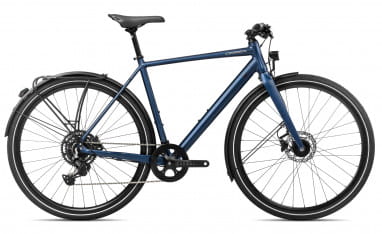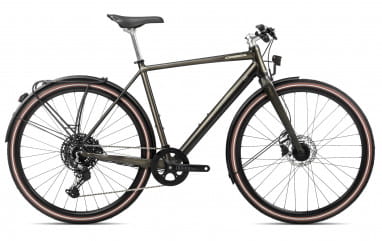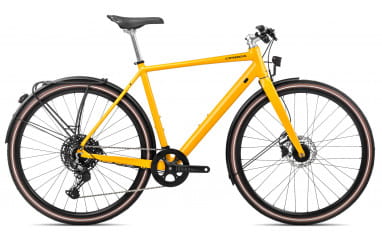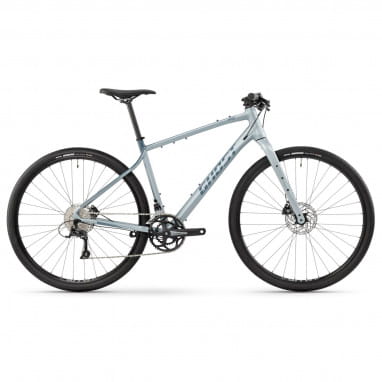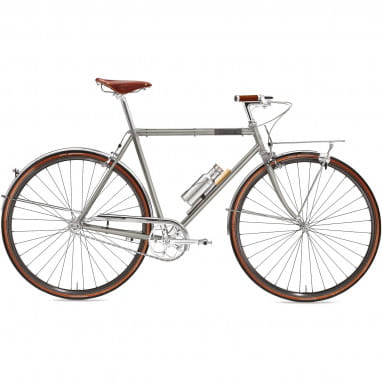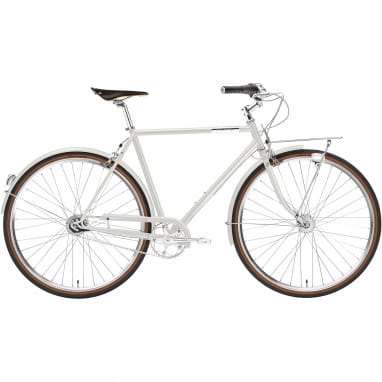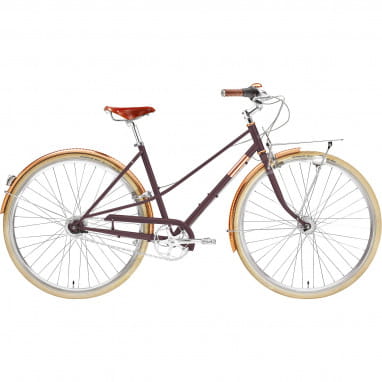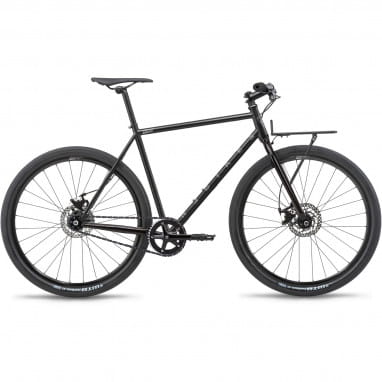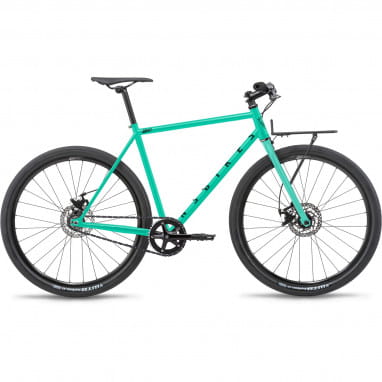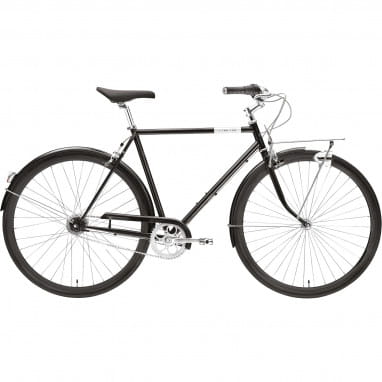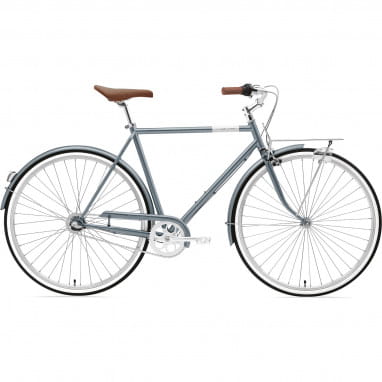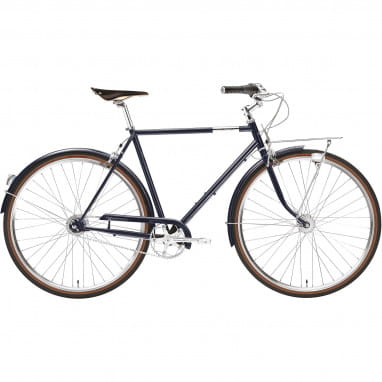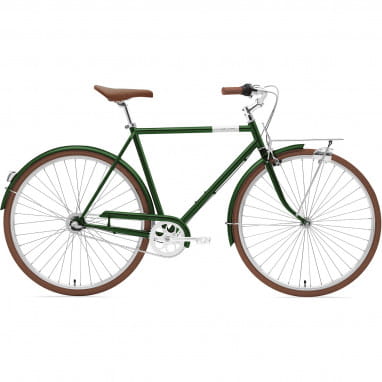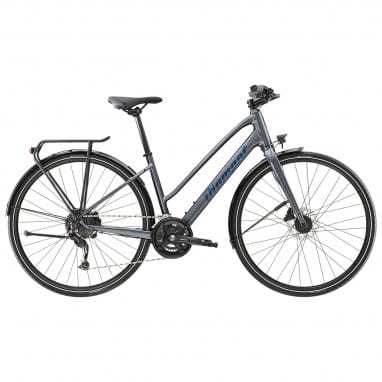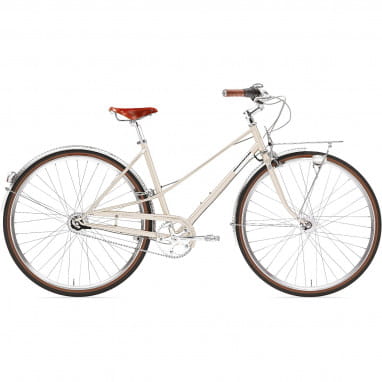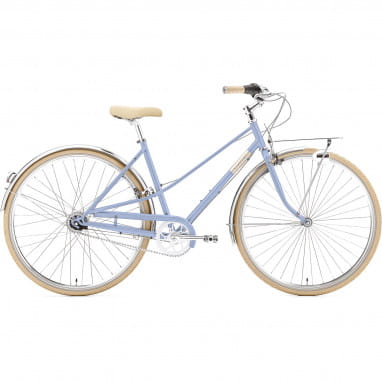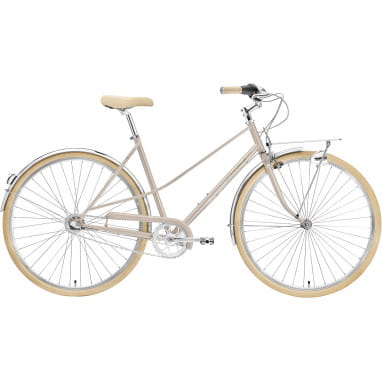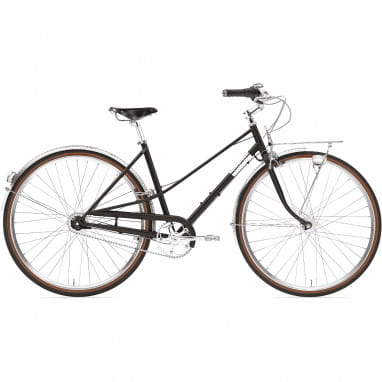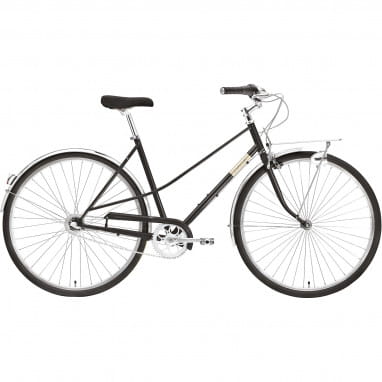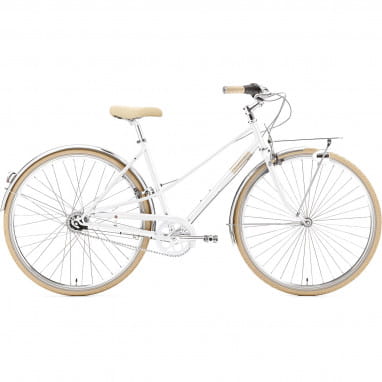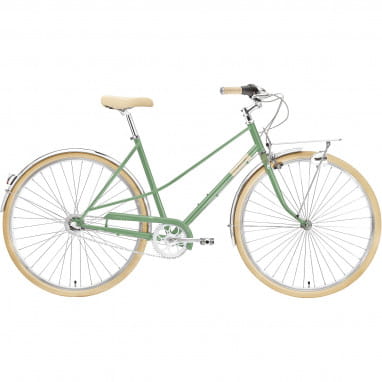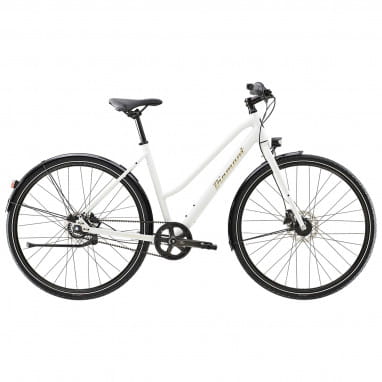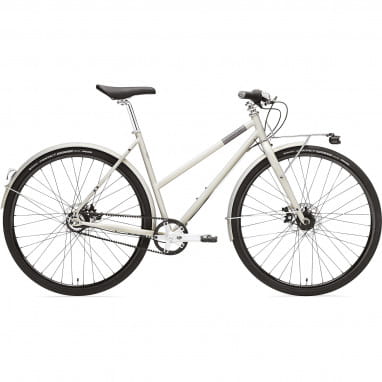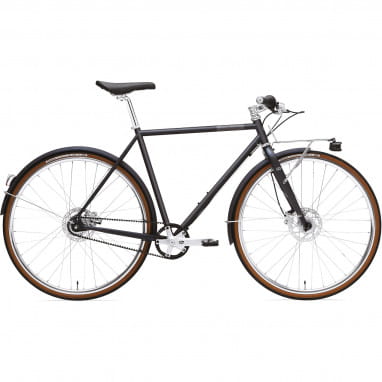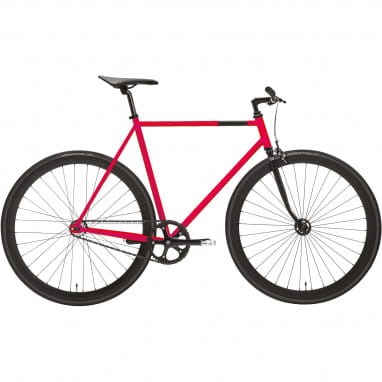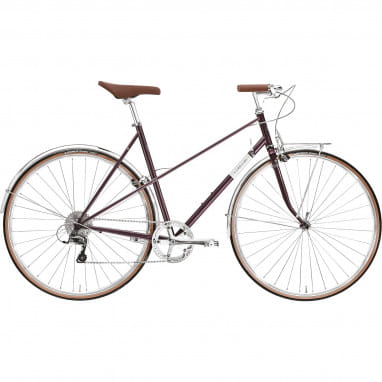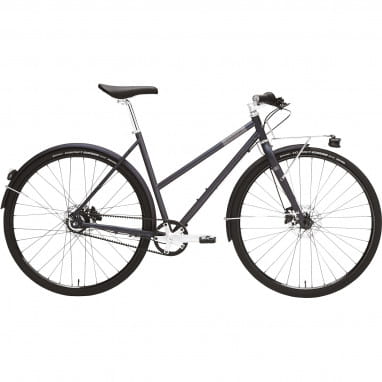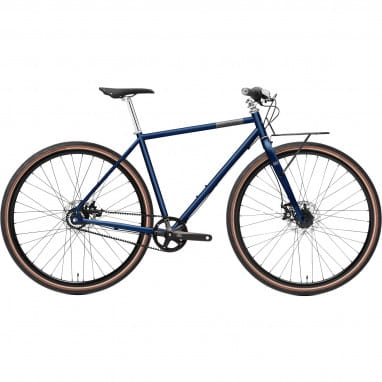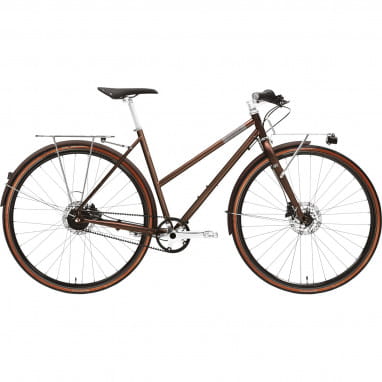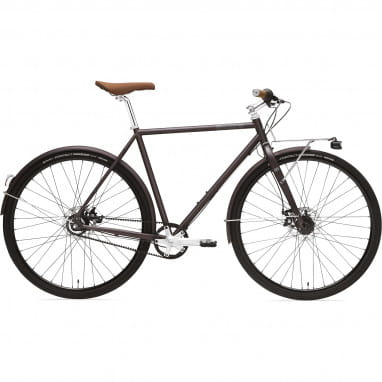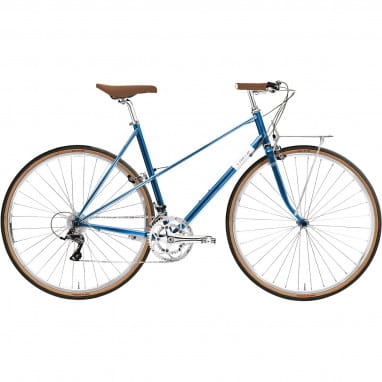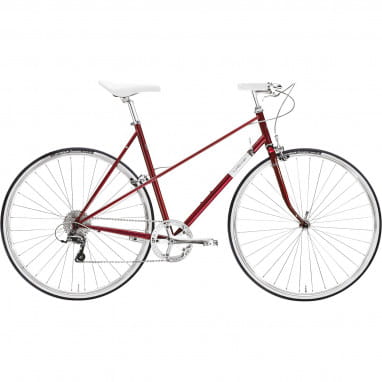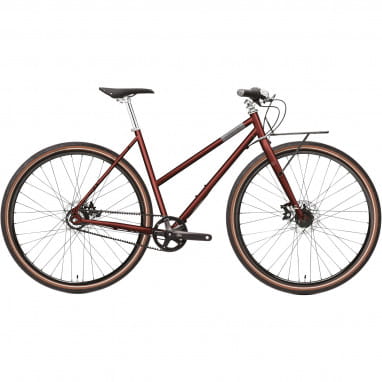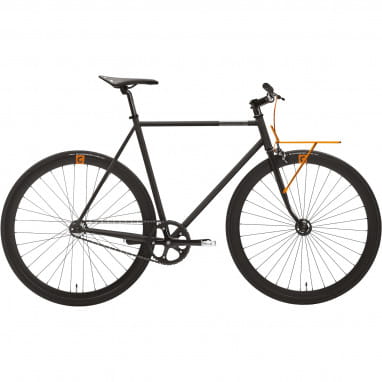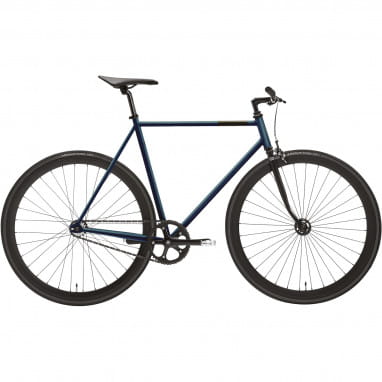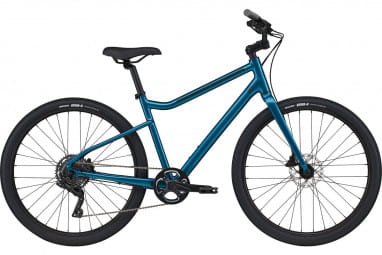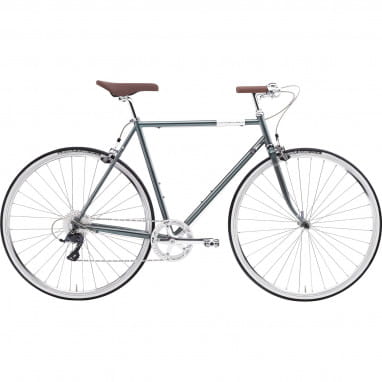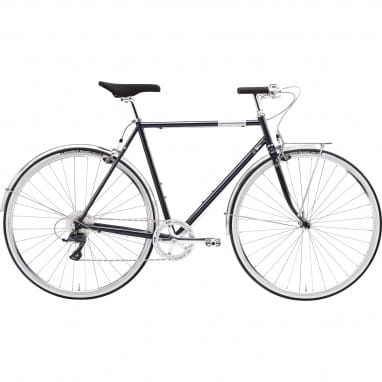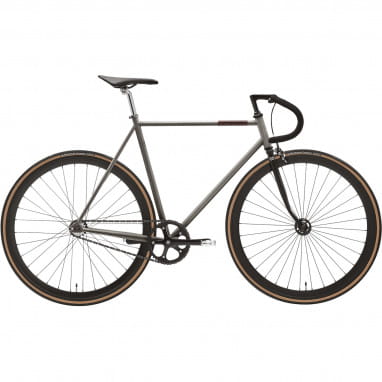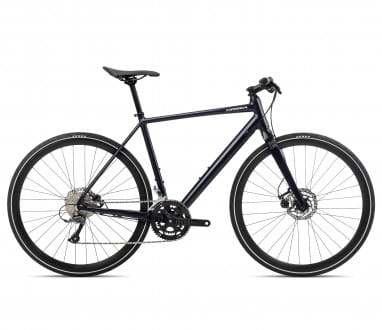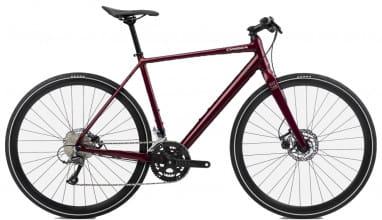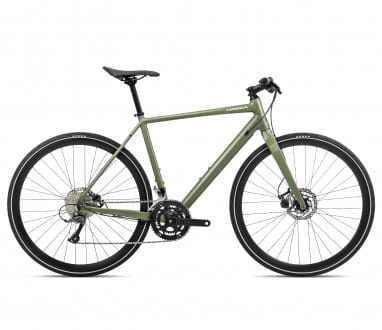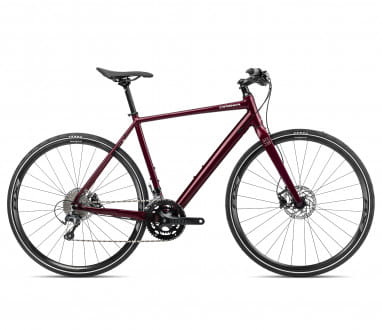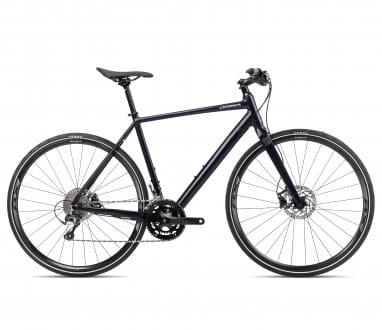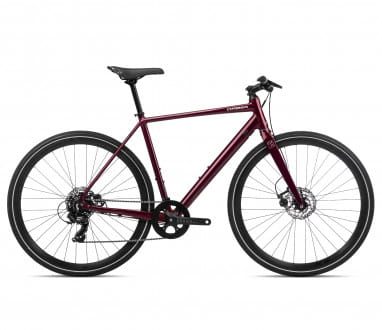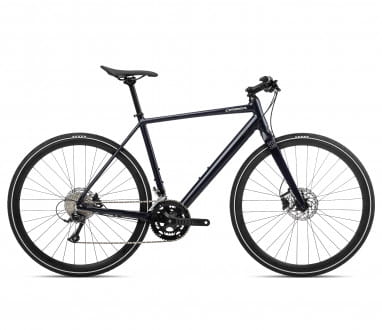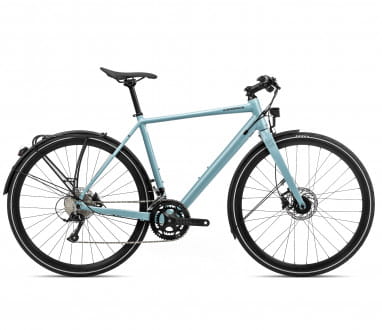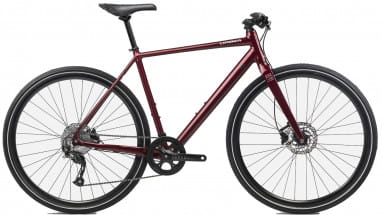“One normal bike please!”, among all those highly specialized (and expensive) performance bikes, a “normal bike” usually is a city bike or a leisure bike. They are closest to their predecessors, those bikes that offered cheap and easy transport to anyone before cars became more common. Urban bikes and touring bikes are ok for those purposes, too, by the way, we’ll tell you in a bit, what distinguishes them from city bikes. Basically, a city bike (also called leisure bike or commuter) is perfectly suited for all of those rides to the places where your busy life takes you.
A city bike comes with practical, comfortable and safe equipment. Therefore, it will not only be a reliable partner on your daily commute, it will also accompany you on smaller tours around your hometown. To sum it up: a city bike works best where your daily life takes place, as long as the area where you live is not too hilly and the roads are reasonably well-paved. But city bike, leisure bike, urban bike, comfort bike, cruiser or commuter – what’s the difference? Just keep reading, our buyer’s guide will help you order the perfect bike for all your biking plans.
What is a city bike, what is an urban bike, what is a fixie?
Here’s the short version: While a city bike is practical, an urban bike is mainly chic. If you want to know some more details, keep reading! There are differences between all those bikes mentioned above, how can you pick and buy the right one? The construction of the frames of those bikes is quite similar. Often, it’s the equipment that makes the difference! Find out which is what in our short city bike overview:
- A city bike is a bike for the city. It is designed for perfect comfort. It is also designed to be practical and safe for everyday use. Therefore, it has a soft saddle, ergonomic handlebars, and all the safety equipment such as fenders, a bell, lights, and a rear rack. A city bike also is equipped to handle anything life will put in front of you. For bad weather, it has mudguards. For traffic controls, it comes with all the mandatory safety features. For your shopping and all the stuff you need for work, it has one or two luggage racks. It’s anything but minimalistic, but it doesn't get more practical!
- An urban bike is also a bike for the city, just minus the equipment. Urban bikes are clean, straightforward and reduced to the minimum. No mudguards, no rack, no lights. The clean look of those bikes is not only beautiful, there are some other advantages, too. No components mean the bikes are cheaper, need less maintenance and weigh much less. Of course, you can retrofit the parts that you don’t want to go without. Depending on the manufacturer, urban bikes are occasionally defined differently. In that case, bikes with an unusual look are called urban bikes, and you will find beauties such as retro bikes or cruisers under this name.
- A leisure bike is the more fun and relaxed (and also cheaper) version of a highly practical city bike, it is great for not too long distances and it wants to spend the afternoon by the lake with you.
- A commuter bike is the 100%-reliable heavy-duty deluxe version of a city bike that is comfortable enough even for longer journeys to work, safe in heavy traffic and as breakdown-proof as bikes can be.
- There are awesome electric versions of city bikes and urban bikes on the market. Thanks to the drive unit, e-bikes can truly replace a car and are a great alternative to using public transport.
- A cruiser bike has a distinctive frame that actually looks like a Harley Davidson chopper’s baby brother.
- A fixie or single-speed bike doesn't have much to offer except a frame and a couple of wheels. The idea of outfitting a bike with as little equipment as possible originally came from New York’s bike messengers. Locking and unlocking their bikes over and over again took too much time, so the bikes were supposed to be as unattractive for thieves as possible and look like they weren't worth stealing. Today these bikes enjoy cult status, you should definitely lock your fixie if you buy one! A real fixie, will even go without brakes. There's no freewheel, you brake by pedaling backwards.
- If you want to go a little sportier, you should look out for a touring bike. Touring bikes or trekking bikes work not only in the city, you can even ride longer tours or do some bike packing on those bikes. Those bikes come with touring equipment such as versatile gear shifts.
- A “Holland Bike” is actually mostly a city bike, it just has distinctive handlebars that curve backwards.
- A retro bike is defined by its nostalgic chic. Retro bikes copy the look and the construction of bikes that were built in the 50s, 60s or 70s. Often the components are replicas of historic bike parts as well, technically they have been updated, of course.
- Cargo bikes are also very popular for inner city transport. A cargo bike has, in addition to a powerful engine, a huge cargo box or cargo space or a long rear rack that can handle loads of luggage.
Things you should know about city bikes
A very comfy geometry
City bikes and urban bikes mostly put you into a very upright riding position. This will on one hand be easy on your back, on the other hand, it ensures that there is not too much weight on your arms and shoulders. In other words: It will let you cycle without back pain, numb arms or hands. Sitting very upright also makes sure that you have a good view and don’t miss what is going on around you and – very important in city traffic – you make it much easier for others to see you, especially if you’re wearing a brightly-colored helmet. That makes a city bike’s geo is not only very comfortable, but also beneficial for your health and safety.
E-bikes for the city
You can buy any bike in an “E” version these days, you could even call city bikes the original pedelecs, since they were among the first bikes that were outfitted with a drive unit, so there is a huge selection of city e-bikes. Usually, city e-bikes have the "smaller" drives of popular manufacturers such as Bosch or Shimano, they have little torque and also smaller batteries. That makes them cheaper and lightweight, but powerful enough for daily errands.
Some bikes are sold as electric urban bikes. However, urban e-bikes rarely live up to their name, the engines are responsible for that. Thanks to the many parts that make an e-bike an e-bike, there is usually not much left of the clean look. But drive units and batteries get smaller and smaller, and control panels can be fitted inside the frame, so more and more urban e-bikes are becoming worthy of the name.
Robust components
The equipment of a city bike is all about comfort, reliability and safety. They have fenders, “big” saddles, bike lights and versatile tires. They also have gear shifts and brake systems that are robust and easy to use. Generally, city biking is about transport rather than performance, and the bikes live up to that. Just take a look at the specifications, there you will find information on what parts the bike comes with.
Which groupset is perfect for a city bike?
Citybikes often have simple hub gears. You use a twist grip on the handlebar to easily adjust the gears and select up to 14 gears depending on the model. Hub gears are particularly durable and require little to no maintenance.
Of course, you can also have a derailleur on a city bike. If you live in a city with a lot of climbs or want to take your bike off-road every now and then, a derailleur shift might be a better choice for you. It will allow you to adapt your bike to your surroundings better than a hub gear will. On some city bikes, you'll find the super-comfortable NuVinci stepless shifters.
If an urban bike has a gear shift, it will be as lightweight as possible, and not have too many speeds. A single-speed bike or fixie, of course, has no gears at all.
Belt drive
Many city bikes have a belt drive instead of a bicycle chain, in order to transfer power from the crank to the rear wheel. Belt drives aren't exactly bargains, but they are (almost) maintenance-free and subject to very little wear and tear.
The best brakes for a city bike
More and more bikes have disc brakes, and city bikes make no exception here. Rotors just work better, which makes them particularly safe when riding in busy traffic. Disc brakes also don't cause abrasion on the rims, so your wheels last longer. There are mechanical and hydraulic disc brakes, with hydraulic brakes being the posher version, but these brakes need maintenance (they must be “bled”) at some point. Rim brakes, however, are cheaper and weigh less, that is why they are often mounted on less expensive bikes. Many city bikes have a coaster brake, you can even buy city e-bikes with a coaster brake.
Which tires for a city bike?
While sporty bikes roll along on really fat or really skinny tires, city bikes and urban bikes come with tires of medium widths between 35mm to 42mm. You can often fit tires of different widths on your city bike. Crudely put, wider tires require heavier pedaling, because the rolling resistance is greater. On the other hand they have better grip and offer better cushioning. Narrow tires are easier to move, but they have less contact (and therefore grip) on the surface.
You can find out which tires are best suited by taking a closer look at the surfaces on which your bike will be rolling. Are there a lot of cobblestones, dirt roads or gravel? In that case, wide tires are better, and some tread pattern won't hurt either. Do you ride mostly on smooth asphalt? Then efficient, narrow tires are ideal.
Most city tires have little tread patterns, just enough to provide good grip in all weather conditions. If you want to use your bike year-round, you can buy winter tires. Just like on cars, a special tread pattern and rubber compound ensure a secure grip in icy temperatures.
A rear rack
There's probably no rear rack on your new urban bike, but there are attachment eyelets for it. A city bike usually has a rear luggage rack, and may even come with a second one, a front luggage rack. Many city bikes have one of the handy click systems MIK by Basil or KlickFIX pre-installed on the rack. In that case it takes only one “click” to attach a bicycle basket.
Side stand
You've probably figured it out already, you'll have to prop your urban bike up on lamppost, a city bike usually has a kickstand.
Mudguards and lighting
You'll need mudguards in bad weather. They keep rainwater from getting swirled up right into your face by your tires. City bikes have fenders. Urban bikes don’t, riders like to mount ass savers and mud guards.
Bike lights are mandatory on public roads, but you can choose to have bike lights with a dynamo, parking lights, a light sensor and daytime running lights, or you can buy battery-powered or rechargeable quick-mount lights.
Mounting points for attachments
While a city bike usually is delivered with everything you could possibly want, an urban bike comes without… without a rack, without a side stand, without a bell, without everything. But to make sure you can set up your bike just the way you want it, the mounting eyelets for all those add-on bike parts are there, and you can add racks, front racks, fenders, or even a lighting system if you like.
Citybikes for men and women
While there are fewer and fewer bikes specifically declared as women's bikes in other bike categories, city bikes are still built as classic women's bikes and as men's bikes.
A wave-frame bike (or “a bike with low entry”) is traditionally considered a ladies' bike. It has a low entry that is not blocked by a high, horizontal top tube. It is therefore particularly comfortable to mount. If you want to install a child seat on the rack, a bike with a low step-through is highly recommendable. Wave frames can also be ridden in a skirt or dress, which is why they used to be women's bikes!
A diamond frame is considered particularly robust and therefore very sporty. Here the top tube attaches just below the saddle, which makes getting on a wobbly affair for many (especially those with shorter legs). A bike with a diamond frame is a classic men's bike.
A trapeze frame is right in the middle between a "women's bike" and a "men's bike." Here the top tube meets the seat tube in the middle between the bottom bracket and saddle. It is equally suitable for ladies and men. Many trekking bikes have a trapeze frame.
Generally, declaring bikes to be “bikes for women and bikes for men” is outdated. Regardless of your gender, you can simply ride the bike that you like and that best suits your cycling life. However, it is important that the frame size fits you well.
That's why you should determine the right bike size before you buy a new bike online. Check out our blog for a buying guide that will help you determine the correct frame size (sorry, German only).
Do traffic regulations affect bikes?
Any vehicle that rides on public roads, is subject to the StVZO (German traffic laws) that requires certain safety equipment for bicycles. This includes reflectors on the wheels and pedals, a white light at the front and a red reflector with a red rear light. You'll also need a bell. Don’t get caught without these parts! Also, the StVZO requires two independently working brakes.
All things considered, an urban bike is a stylish bike for the city, while a city bike is a comfortable, practical bicycle with full equipment.
Is a city bike the right bike for you?
If you value stylish design, you'll be happy with an urban bike. Also, if you don't want to worry about maintaining numerous bike components, you should shop with our urban bikes. It is important to you that your bike is robust and reliable, a few excellent components are more important to you than lots of less-than-perfect gear? Then you should buy an urban bike, especially if you’re on a limited budget. In that case, the many parts that such a bike just doesn't have are a huge advantage.
If you like to ride comfortably, a city bike is perfect for you. Especially when “life happens” and no two days of your week are the same, and you want your bike to be flexible, a city bike offers a variety of uses. The equipment makes the bike independent of the weather and rideable all year round. Especially if you use your bike for leisure time, work, school and university, a city makes you independent, it can handle a lot. If you get on your bike only every now and then, one of the many cheaper models will suffice.
The comfortable tires make both types of bikes rideable on many surfaces.
Your everyday life will be especially effortless if you treat yourself to a city bike with an engine, i.e. an e-bike.
In summary, an urban bike is a particularly cool bike, while a city bike is incomparably practical and comfortable. Both are best suited as an eco-friendly means of transportation in the city.
All the features:
- versatile bike for the city with comfortable tires
- durable construction
- affordable models available
- suitable for year-round cycling, commuting, everyday riding
- can be ridden on all kinds of surfaces; from asphalt to cobblestones
- also allows for smaller bike trips and excursions
How does a city bike ride?
A city bike's design is all about riding comfort, an urban bike can feel quite sporty. The frame geometries differ accordingly, an urban bike usually puts you in a slightly more stretched riding posture. On a city bike you sit very upright.
Most of the frames are made of aluminum, but there are also absolutely indestructible steel frames and every now and then an ultra-light urban bike made of carbon.
The tires also affect the handling, as we have already explained above. Wider tires make for a nice and smooth ride. If the cushioning the tires offer isn’t enough for you, you can install a suspended comfort saddle. Most city bikes don’t have a suspension fork for even more dampening, but some do, or you can retrofit one.
Of course, the weight of a bike depends on the type and number of components and the frame material. An average city bike weighs 12 to 15 kilos, an urban bike will weigh less, while a city e-bike weighs significantly more.
Urban bikes and city bikes offer a relaxed riding experience. Depending on equipment, weight, geometry and tires, they offer either more comfort or a sportier riding experience and brisk propulsion, but always tend to be comfortable rather than offer optimum performance.
What riding a city bike feels like:
- comfortable
- easy and simple
- well cushioned
- somewhere between dynamic and comfortable
What are the advantages of a city bike?
You've probably already guessed some of the advantages of city bikes from the previous paragraphs: They are comfortable, versatile, suitable for everyday use and a real eye-catcher.
City bikes are great for dodging heavy car traffic and avoiding the crowds in public transport. Parking fees, high gas prices and blocked roads are of little interest to urban cyclists. Picture this: While everyone else is stuck in a traffic jam on the way home, you're pedaling from A to B, smiling and enjoying some fresh air.
A bicycle is not only much cheaper in the long run, it is also the most environmentally friendly means of transport ever.
Work, leisure, short trips, shopping, some exercise - a city bike is very versatile. Riding a city bike lets you combine training laps in the fresh air with the routes of your everyday life.
City bikes and urban bikes traditionally will not cost you a fortune. Entry-level models are available for small money. For comparison: A set of expensive MTB wheels with good tires will cost you about as much as a whole city bike.
City bikes make even transporting a lot of luggage easy! Kiddo seats, your briefcase or a picnic basket - the rear rack makes hauling stuff safe and easy.
A city bike’s advantages:
- versatile, lots of options
- independent of traffic or public transportation
- offer a lot of comfort
- safe and easy cycling
- are robust and durable
- lots of equipment options
- many affordable models
How much does a city bike cost?
You can spend quite a bit on a high-quality everyday bike, but there are also plenty of affordable entry-level models. If you want to get the assistance of a drive unit, of course, things get a little more expensive. But even e-city bikes are usually quite affordable.
The entry level of city bikes goes from about 400 to 700 euros. Here you get decent bikes that are great for short rides around town, they are probably much rather leisure bikes, fun and simple – remember? The frames are made of aluminum and you’ll get rim brakes and simple gear shifts. The bikes are a little heavier than higher quality bikes. If you only hop on your bike every now and then and if you don't mind if it needs to be overhauled from time to time, a bike like this is a good choice.
From 700 euros and up to 1700 euros you can buy mid-range city bikes. The gear shifts are getting better, they shift easier and more precisely. In the middle segment, bikes have disc brakes, at the upper end you can expect hydraulic disc brakes. You get good to very good lighting systems and also the quality of the tires is improving. This makes your ride more puncture-proof and you’ll also get better grip on wet surfaces. Also an interesting fact: the bikes get better saddles, ergonomic handlebars and comfortable grips as the price goes up. Even though these components would be quick to replace, it's nice to have some real feel-good stuff right from the start, isn't it?
For 1700 euros and up you can expect top urban bikes. In this price range, they have excellent gearshifts, suspension forks and hydraulic disc brakes from well-known manufacturers. The bikes are lightweight, and they allow for much sportier riding than cheaper bikes. Puncture-proof tires with a longer service life will keep you out of trouble. Here you can find some bikes here that are actually already gravel bikes or sporty hardtails, or even cheaper e-bikes.
But no worries, the most expensive bike isn't necessarily always the best choice. Even for little money you can buy urban bikes and or city bikes that are fun to ride and will get you through your everyday life reliably. With the purchase price, however, the durability usually increases, bikes become easier to use and the riding comfort improves. But the safety increases with the purchase price, too, which is a very important aspect in city traffic. Good lights, brakes of good quality or grippy tires pay off in sticky situations.
The costs at a glance:
The entry level of city bikes goes from about 400 to 700 euros.
From 700 euros and up to 1700 euros you can buy mid-range city bikes.
For 1700 euros and up you can expect top urban bikes.
Gravel bike, mountain bike, road bike, trekking bike and touring bike – what exactly is the difference between a city bike and other types of bikes?
City bike - Mountain bike
A city bike is meant for the city, a mountain bike is meant for off-road riding. While you can definitely ride a hardtail mountain bike in the city, it doesn’t work the other way round. A city bike won’t get far on loose surfaces.
City bike - road bike
A road bike is a highly specialized piece of sports equipment, while a city bike is meant for somewhere in between everyday transport and leisure time. Road bikes are fast, elegant and lightweight, some urban bikes tap into that by sporting a drop bar. It's a lot like mountain biking: you can ride a road bike around town, but you not ever, never can reach the speed that is standard in road cycling on a city bike.
City bike - gravel bike
A gravel bike works pretty much on all kinds of routes, it is therefore also rideable in the city. In addition, a gravel often has racks, fenders and so on, so it is a great alternative to a classic city bike. If athletic riding is what you’re after and if you’re into the drop bar look, you should definitely check out our gravel bikes.
City bike - cross bike or fitness bike
Urban bikes and cross bikes or fitness bikes are very similar. A cross bike has no specific area of use, it can be ridden in the city and off-road. The geometry is designed a little more athletic, the equipment is usually just as minimalistic. Fitness bikes, however, tend to have more gears so they can handle off-road riding better.
Since there are many mounting points, you can retrofit equipment until your fitness/cross bike has become a real city bike.
City bike - touring bike or trekking bike
A touring bike or trekking bike is a real alternative to a city bike. Here, the good riding comfort and the versatile application possibilities absolutely coincide; in fact the line between those two is somewhat blurred. Many touring bikes are ridden mainly around the city, because they are robust and durable, which makes them absolutely reliable in everyday life. Because they are made for longish rides in all weather conditions, they are perfect for year-round use. If you want to leave the city behind and go for a ride in the countryside all of a sudden, a touring bike is also a perfect travel bike.
What should you look for when buying a city bike?
By answering a few simple questions, you can quickly find the perfect city bike:
How often do you plan to ride your bike?
You ride your bike rather rarely and only when the weather is nice? In that case you can buy a bike of the entry-level range for about 400 to 700 euros. If you don't really need your bike, these bikes are a good choice. If you depend on your bike for daily transport, a higher quality urban bike from the mid-range and up is more reliable.
How long will your rides go?
The more time you plan on spending in the saddle, the more it pays off to invest a little more when buying a bike. Along with the purchase price not only the quality increases, also the riding comfort improves. More expensive bikes, for example, have gel saddles that you will sit on comfortably, and high-quality gear shifts make a bike more versatile.
Where and on what kind of surfaces do you want to ride?
If your town has a lot of cobblestones, make sure you have wide tires and good suspension. If there are streetcar tracks where you live, the widest tires possible are a good choice, as they will prevent the tire from "threading" into the tracks if you're lucky. In a city with lots of inclines, lots of gears are very helpful. Apart from that, city bikes work on asphalt and not-too-crazy dirt roads. Lots of inclines call for a better gear shift.
What equipment do you really need?
How many speeds make sense? Do you need disc brakes? Do you want coaster brakes? Do you need a luggage rack? Plug-in lights or a fancy lighting system? Not only can you save a lot of money by downsizing your bike. It will also affect the weight of your bike and the maintenance you'll have to do.
What's the right bike frame size?
Larger children's bikes and youth bikes (with 26 inch tires) are often mini-sized city bikes. Manufacturers then offer them as youth bikes and as small adult bikes. XXL bikes for particularly large or heavy cyclists are often city bikes or urban bikes. So you have a lot of choice when it comes to frame sizes. Some manufacturers offer bike sizes like the ones you know from buying clothes, i.e. from S to XXL. The frame size can also be measured in centimeters, or you can find inch specifications.
Buy an urban bike or city bike from the best manufacturer
We have many different bikes in stock for you. To be able to offer you value for your money, we work with well-known bike manufacturers. This way, we can offer you particularly cheap bikes or high quality bikes and everything in between – many equipment variants, lots of different colors and the bike size that fits you best. Trek, 6KU, Creme Cycles, Orbea, All-City, Bombtrack, Cannondale or Giant build and supply our urban bikes.
You don't know yet which type of bike is best for you? Here on BMO, it’s particularly easy to compare different types of bikes. We explain what mountain bikes, gravel bikes, trekking bikes, dirt bikes, road bikes, and e-bikes can do. We'll also help you buy a cool kid’s bike for your little one. Just read our buyer’ guides, compare and find out which bike you'll be happy with!
Please note that we cannot provide any binding information on the current legal situation and traffic regulation.
